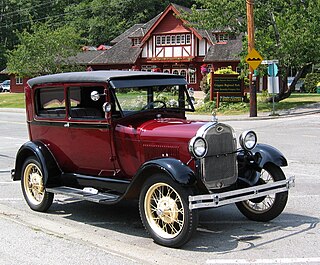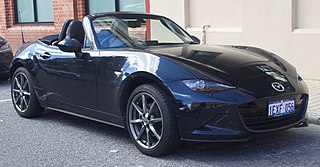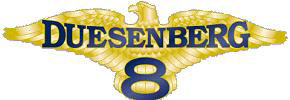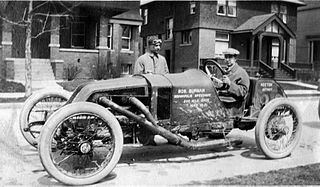See also
| This disambiguation page lists articles associated with the title Duesenberg. If an internal link led you here, you may wish to change the link to point directly to the intended article. |
Duesenberg was an automobile manufacturer active from 1913 to 1937. Duesenberg may also refer to:
| This disambiguation page lists articles associated with the title Duesenberg. If an internal link led you here, you may wish to change the link to point directly to the intended article. |

Auburn is a city in DeKalb County, Indiana, United States. The population was 12,731 at the 2010 census. Founded in 1836 by Wesley Park (1811–1868), the city is the county seat of DeKalb County. Auburn is also known as Home of the Classics.

The straight-eight engine or inline-eight engine is an eight-cylinder internal combustion engine with all eight cylinders mounted in a straight line along the crankcase. The type has been produced in side-valve, IOE, overhead-valve, sleeve-valve, and overhead-cam configurations.

A sedan, or saloon, is a passenger car in a three-box configuration with separate compartments for engine, passenger, and cargo.

A roadster is an open two-seat car with emphasis on sporting appearance or character. Initially an American term for a two-seat car with no weather protection, usage has spread internationally and has evolved to include two-seat convertibles.

Du Pont Motors was founded by E. Paul du Pont to produce marine engines for the Allied nations during World War I. After the war, the Du Pont Motor Company produced extremely high-end automobiles. The cars were manufactured in Wilmington, Delaware.

Duesenberg Motors Company was an American manufacturer of racing cars and high-end luxury automobiles. It was founded by brothers August and Frederick Duesenberg in 1913 in Saint Paul, Minnesota, where they built engines and racing cars. The brothers moved their operations to Elizabeth, New Jersey, in 1916 to manufacture engines for World War I. In 1919, when their government contracts were cancelled, they moved to Indianapolis, Indiana, home of the Indianapolis Motor Speedway, and established the Duesenberg Automobile and Motors Company, Inc. (Delaware). In late 1926, E.L. Cord added Duesenberg to his Auburn Automobile Company. With the market for expensive luxury cars severely undercut by the Great Depression, Duesenberg folded in 1937.

Errett Lobban "E. L." Cord was an American business executive. He was considered a leader in United States transport during the early and middle 20th century.

Auburn was a brand name of American automobiles produced from 1900 through 1937.

Fleetwood Metal Body was an automobile coachbuilder formed on April 1, 1909. Its name derives from Fleetwood, Pennsylvania, home of the company at the start, and lived on for decades in the form of the Cadillac Fleetwood and various Fleetwood trim lines on Cadillac cars.

Frederick Samuel Duesenberg was a German-born American automobile and engine designer, manufacturer and sportsman who was internationally known as a designer of racecars and racing engines. Duesenberg's engineering expertise influenced the development of the automobile, especially during the 1910s and 1920s. He is credited with introducing an eight-cylinder engine, also known as the Duesenberg Straight-8 engine, and four-wheel hydraulic brakes, a first for American cars, in addition to other mechanical innovations. Duesenberg was also patentholder of his designs for a four-wheel hydraulic brake, an early automatic transmission, and a cooling system, among others. Fred and his younger brother, August "Augie" Duesenberg, shared the patents, filed in 1913 and renewed in 1918, for their "walking beam" four-cylinder engine and the Duesenberg Straight 8.

August Samuel Duesenberg was a German- born American automobile and engine manufacturer who built American racing and racing engines that set speed records at Daytona Beach, Florida, in 1920; won the French Grand Prix in 1921; and won Indianapolis 500-mile races, as well as setting one-hour and 24-hour speed records on the Bonneville Salt Flats in Utah in 1935. He also shared with his older brother, Frederick S. "Fred" Duesenberg, patents filed in 1913 and renewed in 1918 for a four-cylinder engine design and the Duesenberg Straight 8.

Barley Motor Car Co. was a manufacturer of automobiles in Kalamazoo, Michigan, and Streator, Illinois. It manufactured the Roamer automobile (1916–29) and, briefly, the Barley (1922–24), and the Pennant (1924–25).

Duesenberg is a brand for electric string instruments founded in 1986 and located in Hannover, Germany. Duesenberg is part of Göldo Music GmbH and is widely known for their classic and distinctive Art Deco designs. By 2004, the company opened a new branch in Fullerton, California.

The Auburn Cord Duesenberg Automobile Museum is an automobile museum located in Auburn, Indiana in the United States. It is dedicated to preserving cars built by Auburn Automobile, Cord Automobile, and Duesenberg Motors Company.

Keeton Motor Company was a pioneer brass era automobile maker based in Detroit, Michigan.
The 1921 French Grand Prix was a Grand Prix motor race held at Le Mans on 25 July 1921. The race was held over 30 laps of the 17.26km circuit for a total distance of 517.8km and was won by Jimmy Murphy driving a Duesenberg. The race did not feature a massed start, with cars released in pairs at one-minute intervals instead.

Garner is a city in, and the county seat of, Hancock County, Iowa, United States. The population was 3,129 in the 2010 census, an increase from 2,922 in 2000.

The Duesenberg Model J is a luxury automobile made by Duesenberg. Intended to compete with the most luxurious and powerful cars in the world, it was introduced in 1928, the year before the stock market crash that led to the Great Depression. The Model J, available with a supercharger after 1932, was sold until 1937.

The Duesenberg Model A was the first automobile in series production to have hydraulic brakes and the first automobile in series production in the United States with a straight-eight engine. Officially known as the Duesenberg Straight Eight, the Model A was first shown in late 1920 in New York City. Production was delayed by substantial changes to the design of the car, including a change in the engine valvetrain from horizontal overhead valves to an overhead camshaft; also during this time, the company had moved its headquarters and factory from New Jersey to Indiana. The Model A was manufactured in Indianapolis, Indiana, from 1921 to 1925 by the Duesenberg Automobiles and Motors Company and from 1925 to 1926 at the same factory by the restructured Duesenberg Motor Company. The successors to the company began referring to the car as the Model A when the Model J was introduced.